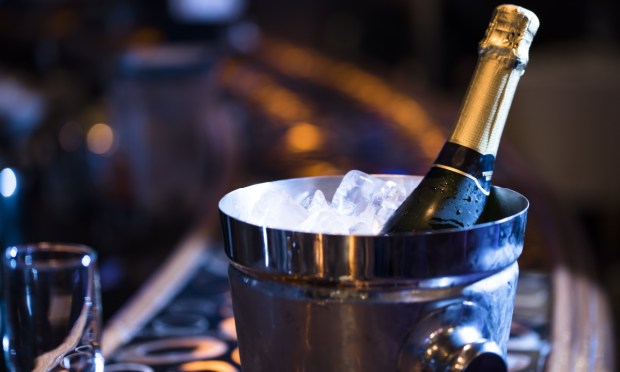Champagne Sales Fizzling as Sober Bars Spark

In-person events are a thing now, with COVID-19 in our rear-view mirror. But with consumers celebrating occasions together once more, why are Champagne sales down?
Whether the pandemic has played a role in this shift, or if younger generations are emphasizing health and wellness over alcohol consumption, the perception around Champagne has consistently been one of restriction.
Champagne has long been associated with special occasions such as weddings, New Year’s Eve, and high-profile events. While this exclusivity has contributed to its allure, it has also inadvertently limited its market. The perception that Champagne should only be reserved for momentous celebrations creates a mindset that keeps people from purchasing it for more regular gatherings or casual get-togethers.
With that, Champagne sales and exports are expected to see a decline this year, according to a Wednesday (July 19) Reuters report. This decrease is attributed to inflation and a return to a more standard pace after two years of extraordinary sales, which were driven by the easing of pandemic-related restrictions.
French industry group Comité Champagne (Champagne Committee) issued a statement projecting sales to reach around 314 million bottles in 2023, which is slightly below the 326 million bottles sold in 2022.
The report revealed that in the first half of the year, shipments totaled 125.8 million bottles, marking a 4.7% decrease compared to the same period in 2022. Exports accounted for 77.7 million bottles, showing a 3.7% decline, while France witnessed a 6.3% decrease with 48.1 million bottles sold.
“The fall in shipments, for France, is attributed to inflation,” a Comite Champagne spokesperson said in a statement to Reuters. “For export, it is difficult to say because the comparisons are for the year 2022, which was a year when exports were very high in the first half. We rather think that after the post-COVID ‘party,’ the situation becomes more normal.”
Champagne producers anticipate steady sales levels for the next three years, averaging around 315 million bottles, the spokesperson said.
The 2023 Champagne harvest is advancing positively, per the news outlet, with minimal frost and hail damage, limited mildew issues, and well-formed grape clusters. However, there are concerns regarding soil water recharge.
Harvesting is scheduled to begin in the first 10 days of September.
The Comité Champagne has set a maximum grape yield of 11,400 kg per hectare for the total 33,700 hectares (83,275 acres) dedicated to Champagne wine production. This is a reduction from the 12,000 kg/ha limit set in 2022.
The purpose of implementing the output cap is to limit the quantity of Champagne released into the market.
The Rise of Sober Bars
In January, Business Insider reported the booming trend of “sober bars,” where fancy mocktails are being sold. At the time, the surge in popularity indicated that “Dry January” was more than just a passing trend, as an increasing number of Americans are embracing alcohol-free lifestyles.
Beyond the usual non-alcoholic beer options, most sober bars provide a diverse range of alcohol alternatives, catering to a niche audience with non-alcoholic wine, spirits, and particularly a variety of cocktails.
And in numerous sober bars emerging in major cities across the U.S., mixed drinks are nearly identical to their alcoholic counterparts — vibrant, beautifully presented and bursting with captivating flavors. Interestingly, a well-crafted non-alcoholic cocktail typically costs the same as a liquor-based drink, and sober bar owners have noted that pricing is not an issue for their customers, as they happily embrace the experience.
“The demographics are absolutely OK with paying a similar price point,” Joshua James, owner of Ocean Beach Cafe, a sober bar in San Francisco, told Insider at the time. “They’re just so stoked to see something on the menu — they’re so stoked to be included.”
According to Nielsen IQ data, non-alcoholic spirit sales have nearly doubled, significantly outpacing the sales growth of non-alcoholic wine and beer.
Compared to previous generations, younger Generation Z consumers show less interest in consuming alcohol. But this shift doesn’t stop with Gen Z — it aligns with a broader wellness movement happening across society, where people of all ages and life stages are striving to take better care of themselves.
Sales data confirms this. From August 2021 to August 2022, the total dollar sales of non-alcoholic drinks in the U.S. amounted to $395 million, showcasing a substantial year-on-year growth of +20.6%.
Additionally, non-alcoholic beer accounted for 85.3% of the sales, representing a market worth of $328.6 million, marking an increase of +19.5% from the previous year. On the other hand, non-alcoholic wine constituted 13.4% of the sales, with a market worth of $52.04 million, experiencing a surge of 23.2% from the previous year.
It’s important to note that these consumers are not necessarily embracing total sobriety, as 82% of non-alcoholic drink buyers are still making some alcoholic beverage purchases.
That said, when they do decide to purchase alcohol, Champagne doesn’t appear to be their top choice.

